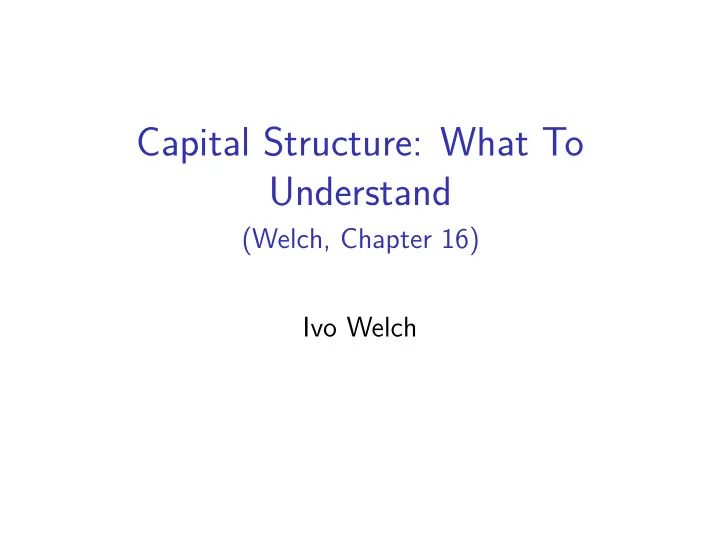

Capital Structure: What To Understand (Welch, Chapter 16) Ivo Welch
Our Plan is Chaos Confuse You! ◮ There are so many choices to consider! Later, you will learn how to think about them. ◮ Further topics can include typical board compositions; staggered boards; institutional activism; fiduciary responsibility; board and ceo turnover, etc.
Cash Flow Rights What is a cash flow right? What are the cash flow rights of debt? What are the cash flow rights of equity??
But Why Oblige Later At All? Why do any owners and managers ever return any money to anyone providing funding, at all?
Straight vs Convertible Debt What is the difference between straight debt and convertible debt ? Is a convertible bond more like debt or more like equity?
Secured vs Unsecured Debt What is the difference between secured or senior debt ; and unsecured or subordinated debt ?
Bond Features To Decide Covenants. Seniority. Collateral. Convertibility. Puttability. Callability. Sinking Fund. Maturity. Duration. Coupon. Fixed-rate vs Floating-rate. ◮ Less so nowadays: Diffuse vs Concentrated. Financial vs Non-Financial.
Bank Loan vs (Public) Bonds How is/was a bank loan different from a bond?
Non-Financial Liabilities What is a non-financial liability (NFL) ?
Are NFL and FD Different? Does financial debt (FD) provide resources to help fund the firm? Do non-financial liabilities (NFLs) provide resources to help fund the firm?
Empirical Magnitudes How big are NFLs usually compared to FD?
Graph: Liab / Assets (Book Value) Figure 1: liabilities
Graph Footnotes ◮ The preceding were averages over all (non-tiny) firms on Compustat. ◮ Watch out: the denominator were BV of assets. Typically, the MV is 1.5 to 2.0 times the BV. ◮ For details, see Ivo Welch, Two Common Problems in Capital Structure Research: The Financial-Debt-To-Asset Ratio and Issuing Activity Versus Leverage Changes , IRF 11:1, 2011, p 1-17.
Common vs Preferred Equity What is the difference between Common Equity and Preferred Equity ?
Equity Features To Decide ◮ Warrants vs Options. ◮ Units. ◮ Class A and Class B shares. ◮ Public vs Private Placements.
Assets — Current Dec Period Dec 26, 28, Ending Dec 27, 2014 2013 2015 15,308 2,561 5,674 ◮ Cash And Cash Equiva- lents 10,005 11,493 14,413 ◮ Short Term Invest- ments
Assets Dec Period Dec 26, 28, Ending Dec 27, 2014 2013 2015 Total 40,356 27,730 32,084 Current Assets 7,851 9,120 7,694 Long Term Investment Property 31,858 33,238 31,428 Plant and Equipment Goodwill 11,332 10,861 10,513 Intangible 3,933 4,446 5,150 Assets
Liabilities – Current Dec Period Dec 26, 28, Ending Dec 27, 2014 2013 2015 10,845 12,210 11,191 ◮ Accounts Payable 2,634 1,596 281 ◮ Short/Current Long Term Debt
Liabilities Dec Period Dec 26, 28, Ending Dec 27, 2014 2013 2015 Total Current 15,667 16,011 13,568 Liabilities 20,036 12,059 13,165 Long Term Debt Other 2,841 3,278 2,972 Liabilities Deferred LT 2,539 3,775 4,397 Liability Charges Minority ◮ ◮ ◮ Interest
Equity Dec Period Dec 26, 28, Ending Dec 27, 2014 2013 2015 Redeemable ◮ ◮ ◮ Preferred Stock Preferred ◮ ◮ ◮ Stock Common 23,411 21,781 21,536 Stock Retained 37,614 33,418 35,477 Earnings Treasury ◮ ◮ ◮ Stock
Pension Liabilities Defined Benefit or Defined Contribution ? ◮ Defined-benefit pension liabilities are among the largest liabilities of older blue-chip firms, governments, and multi-national firms. ◮ US Social Security and Medicaid are defined benefit—and in trouble, too: The demographic transition will be killing them! ◮ In the US, most corps have moved away from defined benefit to defined contribution plans.
A Nasty but Legal Business Buy companies with overfunded defined-benefit pension plans, replace the pension liabilities with the low bidder, take out the difference, and resell the firm. ◮ “First Executive,” run by Fred Carr, did this in around 1985-1990 (with Drexel Junk Bonds). ◮ Predictably, many of these insurers (including FE) lateron went bankrupt themselves. ◮ How could Fred Carr sleep at night?
INTC Outstanding Bonds I Issued Nominal Type Maturity Stated Amount Q4- $915 senior Dec 4.70% $908 2015 2045 Q4- A$800 senior Dec 3.25% $181 2015 2019 senior Dec 4.00% $397 2022 Q3- $1,000 senior Aug 4.90% $1,009 2015 2045 Q3- $7,000 senior Jul 2.45% $1,748 2015 2022 senior Jul 3.10% $996 2022 senior Jul 3.70% $2,247
INTC Outstanding Bonds II Issued Nominal Type Maturity Stated Amount 2011 $5,000 senior Oct 1.95% $1,499 2016 senior Oct 3.30% $1,997 2021 senior Oct 4.80% $1,490 2041 2009 $2,000 jnr Aug 3.25% $1,103 conv 2039 2005 $1,600 jnr Dec 2.95% $975 conv 2035
INTC Bonds Net of Issuing Costs ◮ Total Outstanding Bonds : $22,707 ◮ Less Current Part of Long-Term Debt: –$2,602 ◮ Less Issuing Costs: –$69 ◮ Debt Net of Issuing Costs: $20,036
INTC Debt-Due Term Structure 2021– Year 2016 2017 2018 2019 2020 Amount $1,500 $3,000 $0 $181 $1,750 $17,845
More INTC Capital Structure We omitted discussion of more complexity of ◮ used and unused credit lines, ◮ total interest payments, ◮ hedging out certain liabilities, ◮ the prevailing interest rates at the time (to understand capital structure changes . the prevailing yield curve and credit spreads). ...and Intel has a “vanilla” capital structure.
Measuring Leverage and Precariousness What are reasonable measures of firms’ leverage / precariousness / debt burden?
Possible Debt Measures Financial Debt / Total Assets Financial Debt / Financial Capital Total Liabilities / Total Assets (in book values or in market values?)
Reliability of Book Values How reliable are the book value of debt? How reliable are the book value of equity?
Market Value of Assets How do you calculate the MV of total assets? ◮ The financials only list the BV of assets!
Debt Ratio Determinants What is the biggest determinant of year-to-year changes in most firms’ debt ratios?
Recommend
More recommend